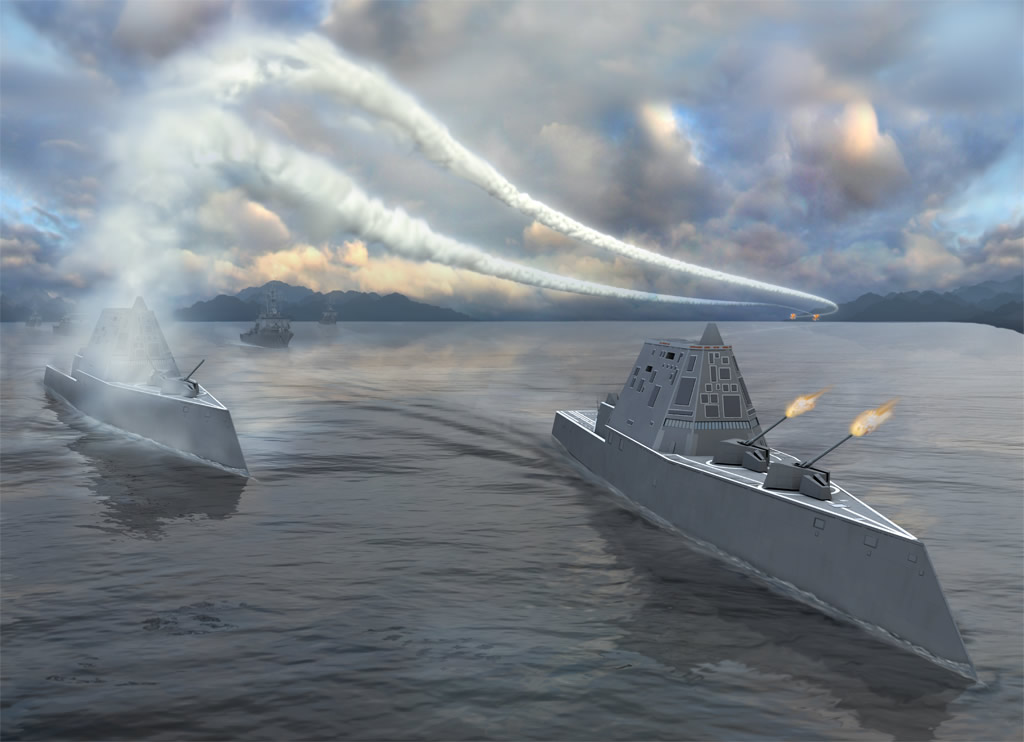
Great reviews of some of the "challenges" with the radical DDG-1000 are bubbl'n to the surface. Both here and elsewhere, many are concerned that, like with LCS, based on slick PPT briefs soaked in a flood of buzz words, we have taken a blind jump into the dark looking for revolutionary vice evolutionary progress for our fleet. The evidence of this is already there - as we are at the point that we will only build 2-8 DDG-1000, build on what we find out for the CG(X), and replace the Arleigh Burkes with a new DDG(X) yet to be designed.
A lot of this article focuses on stability in the hull. I won't say more than, "Yikes! Wet ship!" and tell you to watch this video. The last third of the video is not what I would call "confidence building." I'll leave you engineers to deal with that. I also don't want to spend much time on picking apart all the PR pictures like the one above that show you just off shore with no one shooting back, no 155mm getting close, no populated shoreline, etc - it is just not on the same planet as Taiwan, Beirut, Aden, or anywhere else. No, I want to review the following concerns:
Damage Control:
“I’m sure the people involved in this have been just brilliant about it and I’m being cynical,” said the naval analyst. “I could be wrong. But I’ve got to tell you, you take underwater damage with a hull like that and bad things will happen.”"Stealth" trade-offs:
The senior surface warfare officer noted numerous discussions among other surface warfare officers about the somewhat dismal history of tumblehome ships.
The shape was popular among French naval designers in the late 19th and early 20th centuries, and a number of French and Russian battleships — short and fat, without any wave-piercing characteristics — were put into service. But several Russian battleships sank after being damaged by gunfire from Japanese ships in 1904 at the Battle of Tsushima, and a French battleship sank in 90 seconds after hitting a mine in World War I. All sank with serious loss of life. Both the French and Russians eventually dropped the hull form.
“The Navy has tended almost subconsciously to believe that they might not get hit,” he said. “But getting hit there is just real bad. You have to figure that some of the ships are going to take hits.”
The Zumwalt’s designers have developed a new automated fire-fighting system, a critical need in a ship with a crew of only 125 sailors. But fighting floods is more difficult without muscle power, and that worries surface officers.
Moreover, the naval analyst said, with automated damage control, “a lot depends on how your software is written. That means if your stability goes wrong at the wrong time and you find out you’ve got a software problem, you begin to submerge.”
The prospect of a new cruiser has reignited a debate over the need for stealth itself.Bingo. You are not going to hide a ship the size of the Graf Spee with a superstructure like that. MK.1 Mod. 0 eyeball. There is also the good question, is DDG-1000 a "dead aim or dead end." Let's go back to the hull design. If you have not seen the full video linked above, please go back and watch it. Remember what the scale-model was doing in the Chesapeake? That beings me to something I don't talk much about, but is a Passion - Russian naval design. Say what you want, but a Kirov or a Udaloy are some of the most beautiful ships designed in the last half century. One thing that makes them so appealing to my eye is a direct byproduct of the environment the Russians operate in more often than not - the high seas of the North Atlantic and North Pacific. Watch the video below of the Russian Fleet starting at about the 2 minute point right after the footage of the Slava CG, and then think about the DDG-1000's tumblehome hull design.
“There’s no requirement for stealth,” said a retired senior line officer. “If you’re operating a million-watt radar, the question might be: Why invest in this hull in the first place? And why suffer the peril of an inherently instable hull form?”
The naval analyst scoffed at the stealth requirement. “They’ve gone to enormous lengths in order to be stealthy. And there are serious problems with that. It’s not clear that that’s going to work,” he said. “Stealth was BS to start with and is still BS.”
Critics point out that even if a stealth design is initially successful, some form of counter inevitably will be found.
“They’re not invulnerable, not undetectable,” Brower said. “In a quasi-peacetime environment, they can be detected by anyone with a Piper Cub and a pair of binoculars and a Fuzz Buster.”
Hey, greater minds than mine say that all will be well. Perhaps. I do know the sea though, and she has her own rules, does not lend herself to computer models, and does not like to be told what she can and cannot do.
Hat tip Sid.









No comments:
Post a Comment